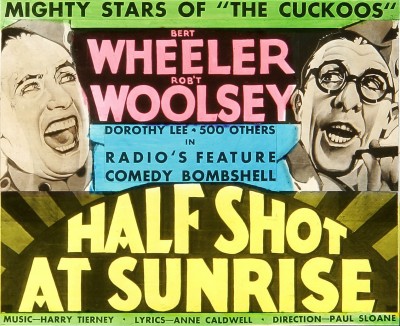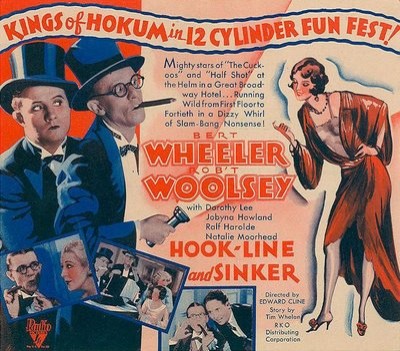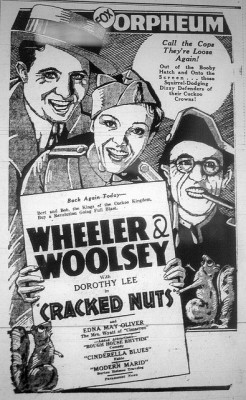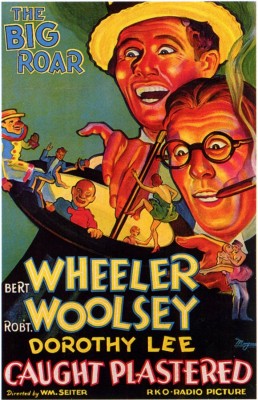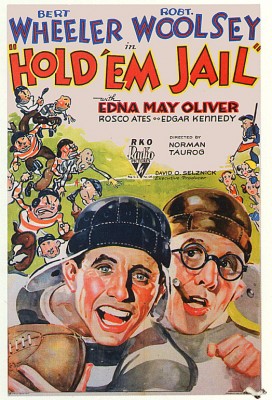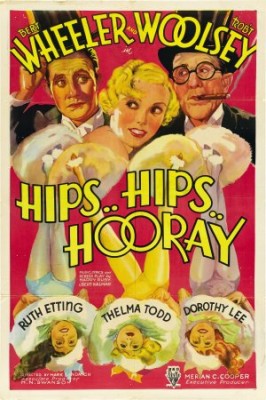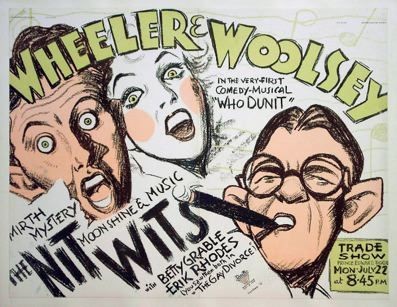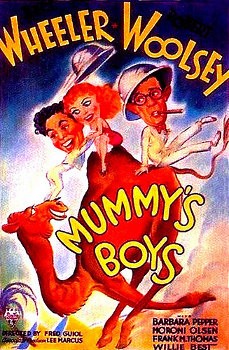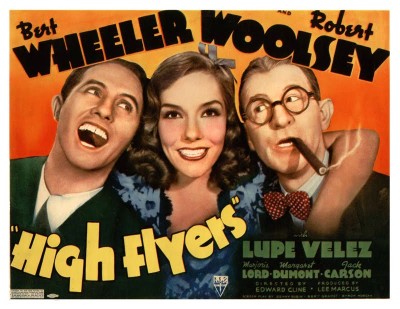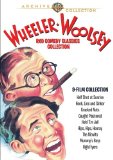| Reviews & Columns |
|
Reviews DVD TV on DVD Blu-ray 4K UHD International DVDs In Theaters Reviews by Studio Video Games Features Collector Series DVDs Easter Egg Database Interviews DVD Talk Radio Feature Articles Columns Anime Talk DVD Savant Horror DVDs The M.O.D. Squad Art House HD Talk Silent DVD
|
DVD Talk Forum |
|
|
| Resources |
|
DVD Price Search Customer Service #'s RCE Info Links |
|
Columns
|
|
|
Wheeler & Woolsey - RKO Comedy Classics Collection
DVD has done much to pluck these teams from obscurity and back into the spotlight, and now at long last comes Wheeler ★ Woolsey - RKO Comedy Classics Collection, a marathon of nine features stretching the team's career almost from beginning to end. The set consists of Half Shot at Sunrise, Hook Line and Sinker (both 1930), Cracked Nuts, Caught Plastered (1931), Hold 'Em Jail (1932), Hips, Hips, Hooray! (1934), The Nitwits (1935), Mummy's Boys (1936), and High Flyers (1937). These, combined with other Wheeler & Woolsey movies previously released by Warner Archive, almost completes the canon. One film, Dixiana (1930) is in the public domain and available from several retailers. Of their starring features as a team, that leaves only The Cuckoos (1930), So This Is Africa (a Columbia release, 1933), Cockeyed Cavaliers, and Silly Billies (1936) yet to be released.
Wheeler & Woolsey are, to be sure, an acquired taste, their antics very much in the style of comedy popular in Vaudeville and on Broadway during the late-1920s. Like most teams they were physical contrasts, and odd ones at that. Robert Woolsey, the fast-talking sharpie, had the slight build of a jockey; he couldn't have weighed more than 100 lbs. dripping wet. With his prominent horned-rim glasses and colossal, ever-present cigar (which made him appear even tinier) he looked like George Burns long before George Burns looked like George Burns (at least the elder Burns of the post-Gracie Allen years). The high-quality video transfers of these films - far superior to public domain versions of several of these titles - are so good one also notices that Woolsey was extraordinarily freckly.
Bert Wheeler, by contrast, was the curly-haired innocent, though in their films he also functioned as a kind of wide-eyed juvenile lead, usually (and most memorably) opposite actress Dorothy Lee, and Wheeler's squeaky, excitable delivery anticipates Eddie Bracken (The Miracle of Morgan's Creek, Hail the Conquering Hero). Relative to Woolsey, Wheeler was handsome yet also strangely unreal. In their early films especially, the blue-eyed Bert wears dark lipstick and thick eye shadow, making him resemble a ventriloquist's dummy.
Half Shot at Sunrise (1930) is a pretty funny comedy about a pair of AWOL doughboys, Tommy (Wheeler) and Gilbert (Woolsey), loose in Paris near the end of World War I. After much carousing, Tommy falls for Annette (Dorothy Lee), the childish daughter of Col. Marshall (George MacFarlane), their C.O., while Gilbert flirts with the exotic, Russian-born Olga (Leni Stengel), who also happens to be the married Col. Marshall's mistress.
Half Shot at Sunrise doesn't have a lot in the way of plot, but it's got one hell of a set. Almost all the exteriors were shot on a positively massive backlot set recreating several city blocks of 1918 Paris. For wide angles glass paintings augment its size but it's still several stories tall and about four square blocks. It's hard to imagine something this massive being constructed for a Wheeler & Woolsey movie, making me wonder if perhaps it was left over from another film, perhaps Universal's All Quiet on the Western Front, though contemporary accounts insist it was constructed specifically for this film.
Despite its early-talkie status, Half Shot at Sunrise is extraordinarily polished. It had an A-picture budget of $529,000, more evidence in favor of an original set. It doesn't have any of the staidness of early talkies though some of the supporting players (notably the two actors playing MPs) are amateurish and E.H. Calvert, playing a general, even has a pronounced lisp.
The comedy is fast and funny, however. As they often did, Bert Wheeler and Dorothy Lee have a cute musical number, though Woolsey outdoes his partner in a faux-ballet fountain dance with Stengel. (*** 1/2 out of *****)
In Hook Line and Sinker (1930), Wheeler & Woolsey are Wilbur Boswell and Addington Ganzy, aggressive insurance salesmen who meet up with heiress Mary Marsh (Dorothy Lee). She's fled her mother's (Jobyna Howland, sister of The Blob's Olin Howland) arranged marriage to socialite John Blackwell (Ralf Harolde), who's actually a gangster.
Wilbur, Addington, and Mary instead decide to refurbish a dilapidated hotel her family owns, with the two men rechristening it as a playground for the rich. Blackwell and Mrs. Marsh turn up, along with a seductive "Duchess" Bessie Vanessie (Natalie Moorhead) and about three dozen gangsters anxious to rob the hotel's jewel-filled safe.
Earning $780,000 against a $287,000 budget, it was one of RKO's biggest hits that year. Hook Line and Sinker (no commas in the title) is a funny entry, with lots of fast-paced verbal humor and less successful visual slapstick at the end. The film entered the public domain in 1958, and has been available by various companies specializing in such films, notably Alpha Video. This version improves on that release, but it seems to be a pretty old transfer, one not nearly as sharp as Half Shot at Sunrise.
Highlights include George F. Marion's performance as the Ritz de la Riveria's ancient bellboy and Hugh Herbert as the world's worst house detective. Unshaven and unkempt, he sleeps right through the vault robbery and subsequent shoot-out. Laurel & Hardy fans will recognize henchman McKay as the threatening sheriff from the team's beloved Way Out West (1937).
Being made prior to enforcement of the Production Code, the film has its share of racy one-liners: "I'd like a room with a good exposure," says McKay. Addington asks, "Are we going to allow that here?"
When Mrs. Marsh asks Addington if he's married, he replies, "No, I got this way riding a bicycle."
"I must be careful of my social stratus," cautions Mrs. Marsh.
"Well," replies Addington, "Sit down and nobody'll notice it."
All told, (***).
Cracked Nuts (1931) has accurately been described as an antecedent to the Marx Bros. more famous Duck Soup, made two years later, though Wheeler & Woolsey's Diplomaniacs (1933), which likewise resembles Duck Soup, also came first, preceding Duck Soup by several months. (And, for that matter, so did the like-minded Million Dollar Legs and International House, both starring W.C. Fields). And in the midst of Cracked Nuts is a wordplay routine that has a lot of similarities to "Who's On First?," Abbott & Costello's signature routine, only they hadn't even teamed up at this point.
Wendell Graham (Bert Wheeler) invests his large fortune to support a revolution in El Dorania so that he'll be crowned king. All this is to impress Minnie (Edna May Oliver), the guardian aunt of Wendell's girlfriend, Betty (Dorothy Lee). Meanwhile, Zander "Zup" Ulysses Parkhurst (Robert Woolsey) wins the crown in a crap game, unaware that the monarchy is threatened with myriad assassination plots.
Wendell, travelling by ocean liner with the corrupt politicians (one is played by Boris Karloff, just prior to his star-making role as Frankenstein) promising him the crown, bump into Aunt Minnie and Betty, they being en route to the former's plantation in El Dorania. Once there, Wendell is reunited with Zup, a childhood pal, though Zup refuses to relinquish the crown even when threatened by revolutionary General Bogardus (Stanley Fields).
Cracked Nuts or, as I like to call it, "Wheeler & Woolsey Meet the Corrupt Politician, Boris Karloff," is pretty amazing, with the jokes flying fast and furiously: "Your royal highness is so cute," offers one admirer. "Yeah," says King Zup, "Well, yours is not so bad, either."
Wendell, determined: "Let's think hard!" "No," says Zup, "Let's do something you can do, too."
Edna May Oliver's acerbic wit, Karloff's effectively oily politician, Ben Turpin's gag appearance near the end as a cross-eyed pilot, and Stanley Fields's overbearing general add enormously to the fun. The "Who's On First"-type routine involves a map with place names like "What" and "Which." Structurally, it's similar to but far from an exact copy of "Who's On First?" Further, Wheeler & Woolsey perform it haltingly, undermining its effectiveness.
The picture quality is back up to the high level of Half Shot at Sunrise and the movie gets (*** 1/2 )
A joke-driven quasi-bootlegging comedy, Caught Plastered (1931) concerns the adventures of penniless vaudevillians Tommy Tanner (Bert Wheeler) and Egbert J. Higginbotham (Robert Woolsey) and their efforts to help drugstore owner "Mother" Talley (Lucy Beaumont) stave off foreclosure proceedings. The result is a rather claustrophobic effort, as 90% of the movie takes place inside that dark and dreary drugstore.
Elsewhere, Harry Walters (Jason Robards, Sr.) is pressuring Mother to sell the shop to him so that he can ship her off to an Old Ladies Home and add it to the bootlegging operation he runs with racketeer Clark (William Scott). Meanwhile, Tommy falls for Peggy (Dorothy Lee, now a blonde), who just so happens to be the daughter of local police chief H.A. Morton (DeWitt Jennings).
The film begins well, opening with a delightfully orchestrated main title theme written by Victor Schertzinger, one of his few talkie scores before turning to directing (The Mikado, Road to Singapore, etc.), music perfectly synchronized with surreal cartoon footage (animated by whom?) of a train and its bumpy ride.
The film has more than its share of verbal humor, though most of the jokes were ancient even in 1931, and peppered with double-entendres. Discussing being fired from their last booking for profanity, Egbert protests, "We didn't use any profanity!" "No," replies Tommy, "But the audience did." There's little in the way of visual humor and no big slapstick finish, but it has its share of laughs. Anticipating It's a Gift, a funny scene casts Charles Middleton as an adamantly disgruntled drugstore customer who refuses to be pleased by the team's super-service.
Conversely, the film is unexpectedly sentimental, with one extended scene of "Mother" sadly making arrangements to move into the Old Ladies Home and overcome with emotion. Tommy and Egbert try to cheer her up with their comedy act, which she initially only finds confusing.
Some have referred to this as a musical comedy, but considering that there's but a single number, "I'm That Way About You," sung by Bert Wheeler and Dorothy Lee, I'd beg to differ.
The video/audio quality is all over the map here as this appears to be a composite of several film sources. At times the image is sharp and strong, at other times it's soft and blurry. As for the movie, (***).
An okay genre hybrid that's mostly a prison comedy but climaxes with a slapstick football match, Hold 'Em Jail (1932) subtly moves the team away from its stagy pre-Code not-quite musical comedies of 1930 and '31 and toward more standard comedy team hijinks. In one long scene, for instance, they work as blacksmiths and get into the kind of trouble one associates more with the Three Stooges. There are more visual gags in this than the previous five films combined and much less Vaudeville style wordplay routines that, depending on one's point of view, is either refreshing or disappointing. However, the supporting cast is especially good and there are a lot of funny if standard sight gags.
Novelty salesmen Curly Harris (Bert Wheeler) and Spider Robbins (Robert Woolsey) aggressively peddle their wares at a swanky nightclub, unaware that it's a front for gangster Whitey's (G. Pat Collins) activities. He's just been ordered by Bidemore State Penitentiary prisoner Butch (Paul Hurst) to shanghai "recruits" for the prison's upcoming football match with Lynwood, another pen. Whitey mistakes Curly and Spider for expert football players - Why wouldn't he? Spider weighs at least 90 pounds. - and sees to it that they're framed for attempted robbery.
At Bidemore, Curley and Spider are taken to the warden's office, which they mistake for their own new quarters, and promptly make themselves at home. But soon enough the warden himself, Elmer Jones (Edgar Kennedy) arrives with his daughter, Barbara (Betty Grable) and spinster sister, Violet (Edna May Oliver), in tow. Naturally, Curly falls for Barbara and Spider flirts with Violet while insulting her simultaneously.
There follows much standard prison comedy hijinks, similar to the antics of Laurel & Hardy in Pardon Us the year before. Further, the climatic football game, while also funny, borrows heavily from Harold Lloyd's The Freshman (1925) and, at least in terms of anarchic spirit if not specific gags, the Marx Bros.' Horse Feathers (1932). Hold 'Em Jail and Horse Feathers were released in September and November, respectively, which would seem to disqualify the Marx Bros. film, but they shared a screenwriter, the great humorist S.J. Perelman. I haven't seen Horse Feathers in at least ten years and can't attest to specific gag sharing, but similar they are.
The movie is just okay, with Wheeler & Woolsey looking less comfortable in their slapstick-heavy characters for this outing, but the picture also follows the established W&W formula. Betty Grable, in the Dorothy Lee part, is more than adequate, and while she'd been a Goldwyn Girl for several years by this point, one tends to associate her most as a wartime pin-up and Fox Technicolor musical star, and therefore it's a bit strange to see her permanent-waved platinum blonde hair and very early '30s makeup and wardrobe.
Edna May Oliver is in fine form, less dour here and more in the spirit of the thing than before, while Edgar Kennedy and his famously slow burn smolders impressively. (Pipe-smoker Kennedy engages in a destructive, tit-for-tat battle with cigar-chomper Robert Woolsey.)
A couple of casting notes: among the football players is the great athlete Jim Thorpe, while Robert Armstrong (Carl Denham of King Kong fame), is fourth-billed in Hold 'Em Jail but doesn't turn up until near the end of the film as the game's announcer, a bizarrely small, insignificant part. The audio/video quality is back up to par here, and the film gets (***).
Besides having the best title of any Wheeler & Woolsey film, Hips, Hips, Hooray! (1934) is also one of their best films overall, to them what A Night at the Opera was for the Marx Bros., with producer-director Mark Sandrich becoming Wheeler & Woolsey's equivalent of the Marx Bros.' Irving Thalberg. Although the trend began the year before in Diplomaniacs, the difference between this and prior W&W vehicles is the expertly done integration of explicitly cinematic musical numbers with the team's comedy personae. Sandrich himself would soon be instrumental in reinventing the form, helming most of the Fred Astaire-Ginger Rogers musicals at RKO. (Rogers, in fact, was slated to appear in Hips, Hips, Hooray!, possibly in Thelma Todd's role, but didn't make it into the film.)
The Marx Bros. connection is likewise explicit. Dominating the score is "Keep On Doin' What You're Doin,'" a song Bert Kalmar and Harry Ruby had originally written for Duck Soup. It's a better fit here.
Lowly street vendors Andy Williams (Bert Wheeler) and Dr. Bob Dudley (Robert Woolsey) agree to hawk salesgirl Daisy Maxwell's (Dorothy Lee) wares lest she lose her job. Believing them to be wealthy cosmetics industry barons she informs her boss and president of Maiden America Beauty Products, Miss Frisby (Thelma Todd) who expresses interest in a merger.
Andy and Dr. Bob take over a lavish office sweet belonging to Mr. Clark (Spencer Charters), who vacates the office when the pair tells him his house is on fire. Impressed by the lavish surroundings, Miss Frisby quickly agrees to a partnership, but when Clark returns, Andy and Dr. Bob mistake Clark's black bag for theirs. Clark's contains a fortune in securities.
That and the conniving of Miss Frisby's crooked business manager, Armand Beauchamp (George Meeker) come to a head at a cross-country auto race, where the Maiden America Beauty Products-sponsored car, driven by Andy and Dr. Bob, runs neck-and-neck with rival Madame Irene's racer. Because nothing goes together quite so well as auto racing and dainty cosmetics.
Hips, Hips, Hooray! is a pre-Code delight from beginning to end. The picture opens with a deliriously suggestive number featuring half-nude models singing "Keep Romance Alive," a number introduced by radio announcer Elsie Cavanna, the rubber-legged patient in W.C. Fields's The Dentist, another pre-Code high water mark. Third-billed (after W&W) Ruth Etting, later the subject of the Doris Day-James Cagney biopic Love Me or Leave Me, performs the three-minute number then disappears, never to be seen again.
Walter Plunkett's over-emphatically glamorous/suggestive costumes and hairstyles are a riot. Thelma Todd is introduced with a hairdo suggesting Marie Antoinette being hit in the head with a plate of spaghetti. Her staff mull about dressed like Liza Minnelli in Cabaret, or maybe Charlotte Rampling in The Night Porter.
The musical numbers are all charming while the dancing (partly supervised by Hermes Pan) by Wheeler, Woolsey, Todd, and Lee, none particularly famous hoofers, is flawlessly performed. Likewise, the wildly funny slapstick auto race is a huge improvement over recent W&W third acts. The video transfer is great and the film gets a solid (****1/2)
Directed by George Stevens, The Nitwits (1935) is much more conventional than Hips, Hips, Hooray! but quite entertaining in its own right. Its story, about a couple of would-be songwriters trying to break into the business while working at a music publishing company's cigar stand, who become prime suspects in the company president's murder, closely resembles Abbott & Costello's later Who Done It? (1942). In that film, A & C play soda jerks trying to break into radio who become chief suspects after the network radio president is murdered. One scene in particular, in which Robert Woolsey renders helpless a dumb cop by tricking him into handcuffing himself, leaves no doubt the writers of Who Done It? had seen Wheeler & Woolsey's film. In the later film Lou Costello and William Bendix play a nearly identical bit.
Here, Wheeler and Woolsey play Johnny and Newton, respectively, who operate a cigar stand in the lobby of music publisher Winfield Lake's (Hale Hamilton) office building. Cashing in on the murderous activities of "The Black Widow," they try unsuccessfully to sell their number "The Black Widow's Going to Get You If You Don't Watch Out." Newton, for his part, has also invented a lie detector-type device resembling an electric chair accessory, forcing whoever sits between its electric conductors to tell the truth. (This also classifies The Nitwits as science fiction, as well as a mystery-comedy.)
Up in Lake's office, George Clark (Erik Rhodes) accuses the music publisher of cheating him out of royalty payments, while Lake in turn accuses accountant Lurch (Arthur Aylesworth) of cooking the books. Fearing the Black Widow, Lake hires famous private eye William Darrell (Fred Keating) to protect him.
But when Lake flirts with his secretary, Mary Roberts (Betty Grable), boyfriend Johnny is so upset he slugs Lake, knocking him cold, and moments later The Black Widow murders Lake. (In an imaginatively staged scene, the killer has bored a hole in the ceiling under a ceiling lamp. He silently slides the lamp to one side and lowers a small imitation black widow spider on a wire. When the terrified Lake looks up, the killer shoots him in the head.
There follows a misunderstanding, with Newton believing Johnny's the killer, and Newton does his utmost to facilitate his pal's escape from the cops swarming the building, but clueless Johnny refuses to skedaddle.
At 81 minutes, The Nitwits is nearly two reels longer than their other comedies, and the pacing here much more methodical. The film is also more a showpiece for a few supporting characters, including an uncredited Arthur Treacher as a twit carrying armloads of tennis equipment who, in a well-timed running gag, keeps colliding dab-smack into various characters, sending rackets and tennis balls flying every which way. Willie Best has several good scenes with W&W, first in a fixed dice game with Woolsey, and later running around with a group of men trying to carry on their craps game in the darkened, unoccupied building where the murderer is still on the loose.
The video transfer is strong while the movie rates a (****)
The consensus is that Wheeler & Woolsey's later movies pale compared to their earlier features, but I found Mummy's Boys (1936) to be okay if conventional. In fact, it's impressively atmospheric for a horror-comedy, a genre yet to be transformed by Bob Hope, Abbott & Costello, and others over the next few years. What Mummy's Boys lacks is a real, monstrous mummy. A few inanimate ones appear, and one of the bad guys dresses up as one for the climax, but horror fans will probably be a bit disappointed. It's possible the absence of a real, monstrous mummy may have had to do with Hollywood's self-imposed prohibition of straight horror films from late-1936 until about 1939.
Wheeler & Woolsey are ditch-diggers Stanley Wright and Aloysius C. Whittaker, first seen working at a construction site led by Tiny Sandford (Modern Times, innumerable Laurel & Hardy comedies). Aloysius spies a want ad for scientific excavators at an archeological dig in Egypt and he and Stanley sign aboard.
But expedition leader Phillip Browning (Frank M. Thomas) is secretly returning artifacts to the site, hoping that by doing so a "curse" that has already claimed ten members of the original excavation party will at last be lifted. Accompanying him is his daughter, Mary (Barbara Pepper, later -unrecognizably so - Doris Ziffel on Green Acres), Professors Edwards (Frederick Burton) and Sterling (Moroni Olsen), and "Catfish" (Willie Best), a stowaway Stanley and Aloysius agree to hire on as their "Man Friday."
The film ain't much but it's brimming with good atmosphere, with sets, props, and lighting resembling Universal's earlier The Mummy (1932) and done on a far more lavish scale than that studio's subsequent Mummy movies of the 1940s. The comedy is at times tiresome: one running gag that falls flat has forgetful Stanley unable to remember important pieces of information, his only recourse is to lay down and take a nap. Like the audience.
The transfer is good but the movie rates just a (***)
High indeed. High Flyers (1937), the team's final film, is like Mummy's Boys not nearly as bad as its reputation would suggest. Where's Mummy's Boys' bad jokes and weak comedy set pieces are in large part offset by some wonderfully atmospheric sets and camerawork, High Flyers has in its favor several bizarre and/or fascinating moments compensating for its extremely ordinary, even dull script. (The screenplay was co-written by busy character comedian Benny Rubin and Bert Granet. Granet later had a major career as a television executive and producer whose credits include The Untouchables and Twilight Zone.)
The plot, such as it is, concerns Jerry Lane (Bert Wheeler) and Pierre Potkins (Robert Woolsey), who operate an elaborate airplane amusement park ride. Their shady pal Dave Hanlon (Jack Carson) offers them a job flying a seaplane out to pick up a package (actually a life preserver, tossed overboard) of what he tells them contain harmless photographs, but which in fact include stolen gems and several boxes of cocaine. Further, Dave's seaplane turns out to belong to the local police department. Jerry and Pierre accidentally get high on the coke and crash the plane in the backyard of the gems' owner, Horace K. Arlington (Paul Harvey), the father of Dave's innocent girlfriend, Arlene (Marjorie Lord), and husband to Martha (perennial Marx Bros. dowager Margaret Dumont).
Mistaking Jerry and Pierre for detectives, Horace confides his concerns about the gems and they become friendly with Arlene and Juanita (Lupe Velez), the family maid.
While the business with the stolen gems is trite, other aspects of the film fascinate. Renamed "parvedon" at the Production Code's insistence but unquestionably coke, when Jerry and Pierre open the boxes a burst of white powder engulf their faces and within seconds they're totally ripped and laughing maniacally. (Needless to say, even with the name of the substance altered, its appearance in a late '30s American film is extremely rare if not unique.)
As for Robert Woolsey, reportedly he was terminally ill with kidney disease while shooting High Flyers, though details surrounding the circumstances of his illness and subsequent death are extremely sketchy. The movie opened in November 1937 yet Woolsey hung on for nearly a year after, finally passing on October 31, 1938. Reportedly his spirited comic dance number with Lupe Velez, "I'm a Gaucho" (music by Dave Dreyer, lyrics by Harry Ruby), was the very last footage Woolsey ever shot. Outwardly he looks and acts just fine throughout the film and this last number with Velez, recalling his "fountain dance" with Leni Stengel in Half Shot at Sunrise, in a sense brings his film career full circle.
Also almost appropriately, the film affords Bert Wheeler the chance to perform an early staple of his stage act, an extended Charlie Chaplin/Tramp character imitation and dance routine with Marjorie Lord. Chaplin himself reportedly greatly admired Bert Wheeler's imitation of him, and it's easy to see why. Most Chaplin imitators superficially get the Tramp character's walk down and maybe a couple of facial expressions or bits (like the dinner roll dance from The Gold Rush). But Wheeler, who in Tramp costume and makeup uncannily resembles Chaplin (they have the same thick wavy hair and facial bone structure), is both nuanced and exacting, incorporating innumerable bits of business Chaplin used in various shorts and features. Of all the Chaplin imitations I've seen through the years, only Robert Downey Jr.'s performance as Chaplin comes as close to the Real Thing.
The image and sound here are up to par and, despite the movie's reputation, for reasons described above I give it a (***).
Video & Audio
See above for comments about individual video transfer assessments, but generally Warner Bros. seems to have sourced a mixture of old and new transfers, the older ones notably softer and more washed out but still okay, while the newer, better transfers, about three-fourths of what's here, look great, even though RKO's surviving film elements are real hit and miss. Overall, I was quite pleased with the presentations. The nine movies are spread across four discs. Curiously, the 70-minute High Flyers gets its own disc while Hips, Hips, Hooray!, The Nitwits, and Mummy's Boys, with a combined running time of nearly four hours, share a single DVD. The Dolby Digital mono is better than adequate, and while there are no alternate audio or subtitle options, the discs are all region-free. No Extra Features, alas. An informative booklet would have been nice.
Parting Thoughts
For fans of classic comedy, Wheeler ★ Woolsey - RKO Comedy Classics Collection is a terrific set, giving viewers the opportunity of watching the same team evolve from the early talkie musical-comedy form, through racy pre-Code comedies that also anticipate RKO's great '30s musicals, and toward more streamline, standardized comedy hijinks as they went along. A DVD Talk Collector Series title.
Stuart Galbraith IV is a Kyoto-based film historian whose work includes film history books, DVD and Blu-ray audio commentaries and special features. Visit Stuart's Cine Blogarama here.
|
| Popular Reviews |
| Sponsored Links |
|
|
| Sponsored Links |
|
|
| Release List | Reviews | Shop | Newsletter | Forum | DVD Giveaways | Blu-Ray | Advertise |
|
Copyright 2024 DVDTalk.com All Rights Reserved. Legal Info, Privacy Policy, Terms of Use,
Manage Preferences,
Your Privacy Choices | |||||||









